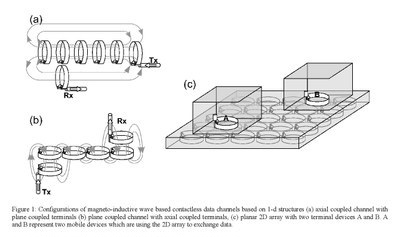Metamaterial Communication Channels
Metamaterial Communication Channels
Novel wave propagation modes for 1 and 2 dimensional metamaterials are potentially very useful for high speed short range data transfer applications. This page introduces this area and its potential applications.

Magneto-inductive waves are a form of propagation which only exists in certain types of magnetic metamaterials formed from inductively coupled resonant circuits. We are investigating these waves as candidates for forming a contactless data channel between suitably designed devices.

In this project so far we have determined the data capacity of simple metamaterial devices which offer novel communication channels. The 'wedding ring' device shown here is based on simple resonating cells formed from slices of copper tube and made resonant at 46MHz using polystyrene capacitors. This is a one dimensional data transfer structure with a bandwidth of ~6MHz.
As the guide has a very low resistance for each cell, thermal noise is extremely low and using our measurements of transfer functions along this device we have established a potential data capacity for this structure in excess of 50Mb/s.
Bandwidth and hence data capacity for these waveguides are very strongly linked to the strength of coupling between cells which for the wedding ring structure is quite low with K=-0.125.
Increasing K(=2M/L) can have quite dramatic consequences for the overall performance as can moving to a two dimensional structure for which bandwidth is approximately doubled.


This structure (left picture) is a design for a device which we have built that achieves >300Mb/s at a resonant frequency of 240MHz, using standard PCB fabrication techniques. The right picture shows the data capacity measured on this device for a pair of terminals located at diagonally opposite corners, when a third energy absorbing terminal is present. The figure shows the relative capacity determined when the third terminal is moved across the grid covering all possible locations. Even when this 'blocking' terminal is on the direct line of sight between the two communicating ports there is only a 3% reduction in overall data transmission capacity.
Potential applications for this technology which we are pursuing as active research include the construction of a 2D data transfer layer to allow simple connection of storage devices and data sources without the need for wires or wireless systems.
A second key goal is described in the the 'Pinless IC and metaboard' project.
